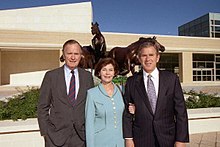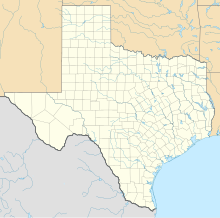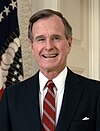| George H.W. Bush Presidential Library and Museum | |
|---|---|
 | |
 | |
| General information | |
| Location | College Station, Texas, United States |
| Coordinates | 30°35′48″N 96°21′12″W / 30.596622°N 96.353381°W |
| Named for | George H. W. Bush |
| Inaugurated | Dedicated on November 6, 1997 Rededicated on November 10, 2007 |
| Cost | $43 million |
| Technical details | |
| Size | 69,049 square feet (6,400 m2) |
| Design and construction | |
| Architect(s) | Hellmuth, Obata and Kassabaum |
| Website | |
| www | |
| ||
|---|---|---|
|
Personal 43rd Vice President of the United States Vice presidential campaigns 41st President of the United States Tenure Policies Appointments Presidential campaigns  |
||
The George H.W. Bush Presidential Library and Museum is the presidential library and burial site of George H. W. Bush, the 41st president of the United States (1989–1993), and his wife Barbara Bush. Located on a 90-acre (360,000 m2) site on the west campus of Texas A&M University at 1000 George Bush Drive West in College Station, Texas, the library is one of 15 administered by the National Archives and Records Administration (NARA).
Description
[edit]
The George H.W. Bush Presidential Library was dedicated on November 6, 1997, as the George Bush Presidential Library and Museum, opening to the public shortly thereafter, and designed by the architectural firm of Hellmuth, Obata + Kassabaum.
Situated on a plaza adjoining the Annenberg Presidential Conference Center and the George Bush School of Government and Public Service, the library is administered by NARA under the provisions of the Presidential Libraries Act of 1955.
The mission of the George H.W. Bush Presidential Library is to preserve and make available for research the official records, personal papers, and artifacts of President George H.W. Bush, to support democracy, promote civic education, and increase historical understanding of U.S. national experience through the life and times of George H.W. Bush.
The textual archives contain more than 44 million pages of personal papers and official documents subject to the Presidential Records Act, as well as personal records from associates connected with President Bush's public career as Congressman, Ambassador to the United Nations, Chief of the U.S. Liaison Office in China, Chairman of the Republican National Committee, and Director of the Central Intelligence Agency. As in all NARA presidential libraries, records are housed in acid-free storage (Hollinger) boxes in a balanced humidity and temperature atmosphere. The archival storage area houses 13,000 cubic feet (370 m3) of records, and the library has a National Security vault holding 3,500 cubic feet (99 m3) of Presidential Records. In addition to memoranda, speeches, and reports found in the textual collection, there is an extensive audio-visual and photographic archive.[1]

The museum has just under 17,000 square feet (1,600 m2) of permanent exhibit space and 3,000 square feet (300 m2) of temporary exhibit space. Permanent exhibits draw on the best of the museum collection to visually convey the essence of George Bush's life and public service career and to illustrate historical events of this period in American history. Changing exhibits explore topics on the Bush Administration, American history, American presidents, and other related topics.[1]
In 2011, the George Bush Presidential Library Foundation was given an overall score of 2 out of 4 by Charity Navigator.[2] The CEO was listed on that site's "10 Highly Paid CEOs at Low-Rated Charities".[3]
Renovations and expansion
[edit]On April 23, 2007, the permanent exhibit closed for complete renovation (though the temporary exhibit gallery remained open, hosting the popular "Traveling White House in Miniature" exhibit). The museum reopened November 10, 2007, with a ceremony during which the former president arrived via parachute jump. The permanent exhibit now features (like many other presidential libraries), a replica of the Oval Office; unlike those other presidential libraries, visitors are able to fully enter the replica, sit behind the president's desk, and have a souvenir photo taken.[4][5]
On November 8, 2019, the Union Pacific Railroad donated its EMD SD70ACe locomotive #4141 to the library, where it will be on permanent display in the pavilion.[6] The exhibit was expected to open in 2020 but is now expected to open in 2024. It will be placed between the library and the Annenberg Presidential Conference Center.[7][8] Unveiled on October 18, 2005 in honor of Bush, it remained in active service until 2009, and later was brought back to participate in Bush's funeral train on December 6, 2018.[9] It subsequently remained in active service following the funeral until its last run between November 8 and November 9, as part of the Union Pacific 4014 Southwest Tour, in which the plans for the display were unveiled. 4141 returned to the presidential library on March 12, 2021.[10]
In addition to UP 4141, the Bush Foundation is also seeking to have a retired Boeing VC-25A and a Sikorsky UH-60 Black Hawk displayed on the library grounds, of which the UH-60 Black Hawk has been confirmed for permanent display.[11][12][13]
On December 2, 2019, a life-size bronze statue of Sully, the President's service dog during his final six months, was unveiled at the site.[14][15]
George Bush Award
[edit]The Presidential Library Foundation also awards the George Bush Award for Excellence in Public Service, which "recognizes an individual's or group's dedication to public service at the local, state, national or international levels". The recipients are given a crystal sculpture designed by Eric Hilton, comprising a "three panel prismatic column of crystal. In the center of the column is a shallow lens engraving of the world." The winners are:[16]
- 2019 John Major[17]
- 2018 Brian Mulroney[18]
- 2016 Bob Dole
- 2013 Sheikha Moza bint Nasser
- 2011 Ronald Reagan
- 2007 Robert M. Gates
- 2006 William "Billy" F. Graham
- 2004 Arnold Schwarzenegger
- 2003 Edward M. Kennedy
- 2001 Mikhail Gorbachev
- 2000 Helmut Kohl
Burials
[edit]
Bush's daughter Pauline Robinson Bush (1949–1953) was originally buried at Putnam Cemetery in Greenwich, Connecticut, but was re-buried at the library in 2000.
Barbara Bush was buried on April 21, 2018, following her death on April 17.[19]
George H. W. Bush was buried on December 6, 2018, following his death on November 30.[20]
See also
[edit]- Presidential Records Act
- MSC Student Conference on National Affairs
- George W. Bush Presidential Center
- Presidential memorials in the United States
- List of burial places of presidents and vice presidents of the United States
References
[edit]- ^ "George H.W. Bush Library Center". www.bush41.org. Retrieved April 16, 2023.
- ^ "George Bush Presidential Library Foundation". Charity Navigator. Retrieved November 30, 2013.
- ^ "10 Highly Paid CEOs at Low-Rated Charities". Charity Navigator. Retrieved November 30, 2013.
- ^ Kever, Jeannie (November 10, 2007). "A more interactive George Bush library and museum reopens". Houston Chronicle. Retrieved November 10, 2007.
- ^ "Surprise Entrance: Bush Parachutes In at Library Reopening". KBTX News. November 10, 2007. Archived from the original on April 5, 2019. Retrieved August 10, 2015.
- ^ Wrinn, Jim (November 8, 2019). "Union Pacific donates SD70ACe No. 4141 to George H.W. Bush Presidential Library; Big Boy 4014 joins celebration". Trains. Archived from the original on September 28, 2020. Retrieved September 8, 2020.
- ^ Oder, Michael; Hogan, Kendall. "'Bush 4141' locomotive coming to Bush Library at Texas A&M". KBTX News. Retrieved September 8, 2020.
- ^ Isenberg, Sydney (November 8, 2019). "Union Pacific 4141 to be permanently displayed at George H.W. Bush Presidential Library". KXXV News. Retrieved September 8, 2020.
- ^ "George H.W. Bush Funeral Train". Union Pacific Railroad. Retrieved December 2, 2018.
- ^ Reilly, Mike (March 21, 2021). "Union Pacific 4141 Makes Last Stop At Bush Museum" (Press release). Retrieved March 22, 2021.
- ^ Luna, Marcy de (January 3, 2019). "Marine One helicopter to land permanent spot at George H.W. Bush Library and Museum exhibit". Houston Chronicle. Retrieved November 11, 2019.
- ^ Britto, Brittany (April 8, 2019). "Bush Foundation wants Air Force One displayed in College Station". Houston Chronicle.
- ^ "Bush library wants the plane and the locomotive". KWTX News. Retrieved November 11, 2019.
- ^ "Statue Of George H.W. Bush's Service Dog Coming To Bush Library". Texas A&M Today. November 19, 2019. Retrieved September 26, 2020.
- ^ Angeline Jane Bernabe; Will Linendoll. "Statue commemorates President George H.W. Bush's service dog, Sully". Good Morning America. Retrieved September 26, 2020.
- ^ "George Bush Award for Excellence in Public Service". George Bush Presidential Library Foundation. Retrieved August 10, 2015.
- ^ "The 2019 George Bush Award For Excellence in Public Service Presented to Former British Prime Minister Sir John Major". George & Barbara Bush Foundation. December 4, 2019. Retrieved August 27, 2021.
- ^ Foundation, George Bush Presidential Library. "2018 George Bush Award For Excellence In Public Service Presented To Former Canadian Prime Minister Brian Mulroney". www.prnewswire.com (Press release). Retrieved August 27, 2021.
- ^ Schallhorn, Kaitlyn (April 21, 2018). "Barbara Bush's funeral attended by Melania Trump, Clintons, others". Fox News. Retrieved April 22, 2018.
- ^ Foussaines, Chloe (December 4, 2018). "George H.W. Bush To Be Buried at His Presidential Library and Museum in College Station, Texas". Town & Country. Retrieved September 8, 2020.
External links
[edit]- George H.W. Bush Presidential Library and Museum
- George H.W. Bush Presidential Library Foundation
- "Life Portrait of George H. W. Bush", from C-SPAN's American Presidents: Life Portraits, broadcast from the George H.W. Bush Presidential Library and Museum, December 13, 1999




